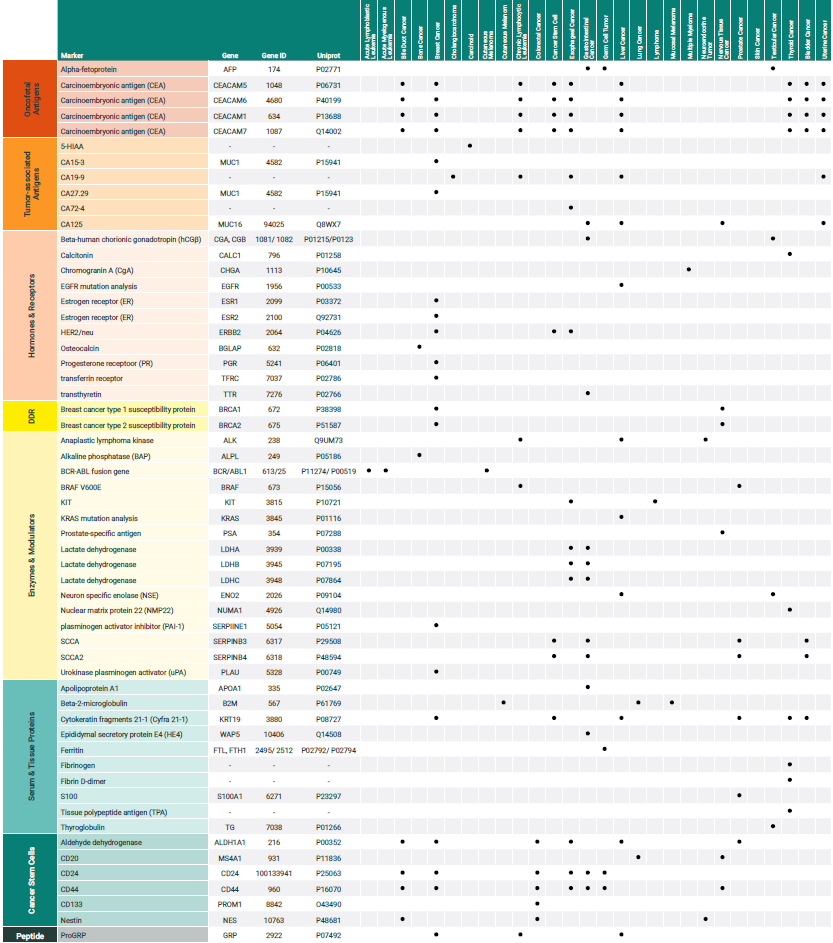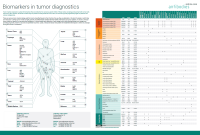Biomarker werden definiert als „Stoffe, Strukturen oder Prozesse, die im Körper oder in dessen Produkten gemessen werden können und die Inzidenz von Ergebnissen oder Krankheiten beeinflussen oder vorausbestimmen können“1. Bestimmte physiologische Erkrankungen sind geprägt durch das Vorhandensein oder durch veränderte Konzentrationen von Substanzen, die für eine solche Erkrankung typisch sind. Substanzen wie Protein und Peptid können problemlos gemessen werden und werden daher häufig als Biomarker verwendet.
Biomarker in der Tumordiagnostik
Tumormarker stehen für eine Untergruppe von Biomarkern, die bezeichnend für das Krebswachstum sind. Die meisten dieser Marker werden nicht nur von normalen Zellen, sondern auch von Tumorzellen produziert. Die Konzentrationen, in denen sie in Körperflüssigkeiten wie Urin, Speichel oder Blut vorhanden sind, sind jedoch bei Patienten mit verschiedenartigen Malignomen normalerweise deutlich höher.
Es werden eine Vielzahl von Tumormarkern23 verwendet, die anhand ihrer Funktion, der Art und Weise, wie sie erkannt werden, oder der Art von Stichprobe, in der Sie gemessen werden, klassifiziert werden:
- Onkofetale Antigene
- Tumorassoziierte Antigene
- Hormone und Hormonrezeptoren
- Enzyme und Isoenzyme
- Serum und Gewebeproteine
- Cancer stem cells4
- andere Tumormarker wie genetische Marker und Biomoleküle
Protein Tumor Marker
Protein Tumor Marker und ihr Anwendungsbereich.
Ein perfekter Tumormarker ist sehr spezifisch und unterscheidet zuverlässig zwischen gesunden Personen und Krebspatienten. Es kann ein allgemeiner Tumormarker oder ein für eine bestimmte Krebserkrankung spezifischer sein. Er sollte ein Tumoren im Frühstadium frühzeitig erkennen und gleichzeitig Tumorstadien unterscheiden und einen prognostischen Wert für das Ergebnis und ein mögliches Rezidiv haben. Schließlich sollte er mit bewährten Verfahren leicht messbar sein, um Änderungen im Verlauf einer Behandlung nachzuvollziehen.
Gängige Marker erfüllen nicht alle Punkte auf der Wunschliste für den perfekten Tumormarker. Vielmehr werden mehrere Marker in der Regel zusammen verwendet, um eine zuverlässige Diagnose, Prognose, Stadienbestimmung und Überwachung einer Vielzahl von verschiedenen Krebsarten zu ermöglichen5.
Wie erfolgt die Messung von Tumormarkern?
Proteine bzw. Peptide sind derzeit die Mehrheit. Sie können demzufolge qualitativ und quantitativ mit immunologischen Verfahren wie ELISA, Immunhistochemie, Immunfluoreszenz, Durchflusscytometrie oder anderen Verfahren, je nach Art des Markers und der Probe, gemessen werden.
Eine wachsende Zahl von Tumormarkern basieren auch auf genetischen Variationen6. Veränderte Expressionsmuster und Mutationen in bestimmten Onkogenen haben keinen Einfluss auf die Art der malignen Erkrankung, sondern sind ebenfalls Determinanten für das Ansprechen auf die Behandlung.
Protein-Tumormarker in verschiedenen Geweben

Protein-Tumormarker und ihre Standorte.

Hol dir dein Tumormarker Poster!
Wenn Sie auf den unten stehenden Link klicken, können Sie eine Kopie unseres Posters über Protein-Tumormarker im PDF-Format herunterladen.
PDF HerunterladenIn der obigen Tabelle sind eine Reihe von Protein- und Peptidmarkern zusammengestellt, die typischerweise zur Diagnose und Überwachung verschiedener bösartiger Erkrankungen verwendet werden. Die erste Spalte klassifiziert die verschiedenen Marker als onkofetale Antigene, tumorassoziierte Antigene, Hormone und Hormonrezeptoren, Iso-/Enzyme, Serum- und Gewebemarker sowie Krebsstammzellmarker. Die Matrix gibt an, für welche Krebsarten die verschiedenen Marker verwendet werden können.
Tumor Marker Antikörper
| Marker class | Marker | Gene | Cancer type |
| Oncofetal antigens | alpha-Fetoprotein | AFP | liver, germ cell tumors, ovarian, testicular |
| Oncofetal antigens | CEACAM5 | CEACAM5 | esophageal, bile duct, colorectal, breast, thyroid |
| Oncofetal antigens | CEACAM6 | CEACAM6 | esophageal, bile duct, colorectal, breast, thyroid |
| Oncofetal antigens | CEACAM1 | CEACAM1 | esophageal, bile duct, colorectal, breast, thyroid |
| Oncofetal antigens | CEACAM7 | esophageal, bile duct, colorectal, breast, thyroid | |
| Tumor associated antigens | Mucin 1 | MUC1 | breast |
| Tumor associated antigens | TAG-72 | - | bile duct, gastric cancer |
| Tumor associated antigens | - | carcinoid | |
| Tumor associated antigens | CA125 | MUC16 | germ cell tumors, lung, OC, uterine |
| Tumor associated antigens | CA15-3 | MUC1 | breast |
| Tumor associated antigens | - | cholangiocarcinoma, colorectal, gastrointestinal, lung, uterine | |
| Tumor associated antigens | - | gastrointestinal | |
| Hormes and receptors | CGB | CGB | choriocarcinoma, testicular |
| Hormes and receptors | Calcitonin | Calca | medullary thyroid cancer |
| Hormes and receptors | CHGA | CHGA | neuroendocrine tumors |
| Hormes and receptors | PGR | PGR | breast |
| Hormes and receptors | Transthyretin | TTR | ovarian |
| Hormes and receptors | Calcitonin | Calca | thyroid |
| Hormes and receptors | EGFR mutation analysis | EGFR | lung |
| Hormes and receptors | ESR1 | breast | |
| Hormes and receptors | Estrogen receptor (ER) | ESR2 | breast |
| Hormes and receptors | HER2/neu | ERBB2 | breast, esopahgeal, gastrointestinal |
| Hormes and receptors | Osteocalcin | BGLAP | bone |
| Hormes and receptors | Transferrin receptor | TFRC | breast |
| Hormes and receptors | Transthyretin | TTR | germ cell tumors |
| Enzymes and modulators | Alkaline Phosphatase | ALPL | bone |
| Enzymes and modulators | C-Abl Oncogene 1 | BCR/ABL1 | chronic myelogenous leukemia, acute lymphoblastic leukemia, acute myelogenous leukemia |
| Enzymes and modulators | Prostate Specific Antigen | PSA | prostate |
| Enzymes and modulators | Lactate Dehydrogenase A | LDHA | germ cell tumors, gastric |
| Enzymes and modulators | Lactate Dehydrogenase B | LDHB | germ cell tumors, gastric |
| Enzymes and modulators | Lactate Dehydrogenase C | LDHC | germ cell tumors, gastric |
| Enzymes and modulators | SERPINB3 | SERPINB3 | esopahgeal, lung, ovarian, squamous cell carcinoma |
| Enzymes and modulators | SERPINB4 | SERPINB4 | esopahgeal, lung, ovarian, squamous cell carcinoma |
| Enzymes and modulators | Plasminogen Activator, Urokinase | PLAU | breast |
| Enzymes and modulators | BRAF V600E | BRAF | colorectal, skin |
| Enzymes and modulators | KIT | KIT | gastrointestinal, mucosal melanoma |
| Enzymes and modulators | KRAS mutation analysis | KRAS | lung |
| Enzymes and modulators | Neuron specific enolase (NSE) | ENO2 | lung, thyroid |
| Enzymes and modulators | Nuclear matrix protein 22 (NMP22) | NUMA1 | UBC |
| Enzymes and modulators | plasminogen activator inhibitor (PAI-1) | SERPINE1 | breast |
| Serum and tissue proteins | CYFRA21.1 | KRT19 | breast, lung |
| Serum and tissue proteins | WFDC2 | WAP5 | ovarian |
| Serum and tissue proteins | Apolipoprotein A1 | APOA1 | germ cell tumors |
| Serum and tissue proteins | Beta-2-microglobulin | B2M | chronic lymphocytic leukemia, lymphoma, multiple myeloma |
| Serum and tissue proteins | Cytokeratin fragments 21-1 (Cyfra 21-1) | KRT19 | breast, esopahgeal, lung, skin, UBC, uterine |
| Serum and tissue proteins | Ferritin | FTL, FTH1 | liver |
| Serum and tissue proteins | Fibrin D-dimer | - | UBC |
| Serum and tissue proteins | Fibrinogen | - | UBC |
| Serum and tissue proteins | S100 | S100A1 | skin |
| Serum and tissue proteins | Thyroglobulin | TG | thyroid |
| Serum and tissue proteins | Tissue polypeptide antigen (TPA) | - | UBC |
| Cancer stem cells | Aldehyde dehydrogenase | ALDH1A1 | bile duct, breast, gastrointestinal, lung, skin |
| Cancer stem cells | MS4A1 | cancer stem cells, lymphoma, prostate | |
| Cancer stem cells | CD24 | CD24 | bile duct, breast, cancer stem cells, gastrointestinal, germ cell tumors, liver |
| Cancer stem cells | CD44 | CD44 | bile duct, breast, cancer stem cells, gastrointestinal, germ cell tumors, liver, prostate |
| Cancer stem cells | Nestin | NES | bile duct, cancer stem cells, nervous tissue |
| Oncofetal antigens | Alpha-fetoprotein | AFP | germ cell tumors, liver, testicular |
Literaturreferenzen
- : "Carcinoembryonic antigen (CEA) as tumor marker in lung cancer." in: Lung cancer (Amsterdam, Netherlands), Vol. 76, Issue 2, pp. 138-43, (2012) (PubMed).
- : "Genomic EWS-FLI1 fusion sequences in Ewing sarcoma resemble breakpoint characteristics of immature lymphoid malignancies." in: PloS one, Vol. 8, Issue 2, pp. e56408, (2013) (PubMed).
- : "Cancer stem cells: the challenges ahead." in: Nature cell biology, Vol. 15, Issue 4, pp. 338-44, (2013) (PubMed).
- : "Wnt signaling in cancer." in: Oncogene, Vol. 36, Issue 11, pp. 1461-1473, (2017) (PubMed).
- : "Warburg and Krebs and related effects in cancer." in: Expert reviews in molecular medicine, Vol. 21, pp. e4, (2020) (PubMed).
- : "Role of Matrix Metalloproteinases in Angiogenesis and Cancer." in: Frontiers in oncology, Vol. 9, pp. 1370, (2019) (PubMed).
- : "Hallmarks of Cancer: New Dimensions." in: Cancer discovery, Vol. 12, Issue 1, pp. 31-46, (2022) (PubMed).
- : "Cancer proteogenomics: current impact and future prospects." in: Nature reviews. Cancer, Vol. 22, Issue 5, pp. 298-313, (2022) (PubMed).
- : "The use of single-cell multi-omics in immuno-oncology." in: Nature communications, Vol. 13, Issue 1, pp. 2728, (2022) (PubMed).
- : "Claudin18.2 is a novel molecular biomarker for tumor-targeted immunotherapy." in: Biomarker research, Vol. 10, Issue 1, pp. 38, (2022) (PubMed).
- : "The role and mechanism of claudins in cancer." in: Frontiers in oncology, Vol. 12, pp. 1051497, (2022) (PubMed).
Zusätzliche Referenzen
- National Cancer Institute - Tumor Markers. Internet: http://www.cancer.gov/about-cancer/diagnosis-staging/diagnosis/tumor-markers-fact-sheet

Goal-oriented, time line driven scientist, proficiently trained in different academic institutions in Germany, France and the USA. Experienced in the life sciences e-commerce environment with a focus on product development and customer relation management.
Mehr Informationen zum Autor



